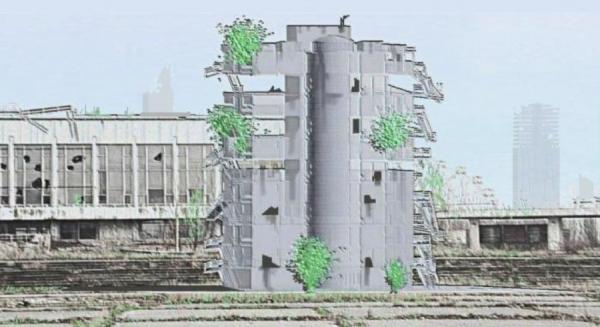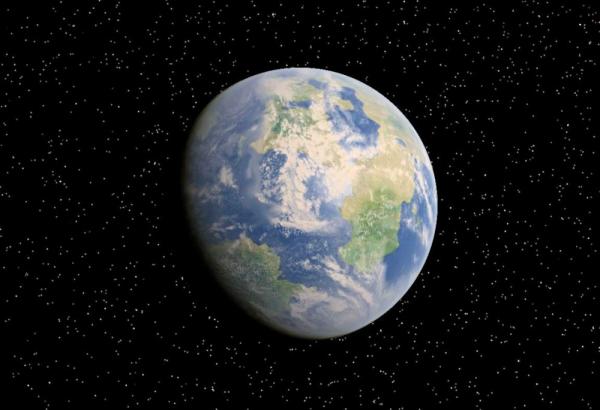BY LETTER
Morrow
Galactography > Regions of Space > Middle Regions/Hinter-regions
Galactography > Systems and Worlds > Systems & Worlds M - N
Galactography > Systems and Worlds > Systems & Worlds M - N
Morrow; a lost colony in the inner Middle Regions | |
 Image from Steve Bowers | |
| The cities of Morrow are gradually collapsing as trees and grassland colonise the broken ruins | |
Morrow : Data Panel | |
| Star | HD 100607 |
|---|---|
| Distance from Sol | 191 ly |
| Type | G8iv |
| Luminosity | 0.804 Sol |
| Planet | Morrow |
| Orbit | 0.896 AU |
| Year | 0.87 standard years |
| Day | 31 standard hours |
| Tilt | 21 degrees |
 Image from Steve Bowers | |
| The world of Morrow from space shows no lights from its empty cities | |
Located 191 light years antispinward from Sol, Morrow was originally a xericGaian world a little larger than Earth, with a medium sized moon. This world was colonised in 2220 AT by a venture vessel from Negsoa (Mu Arae bII) launched at the height of First Federation power, but arriving centuries later. The colonists were largely of Southern African lineage.
Morrow was sparsely settled for several hundred years, while initial terraformation occurred; a swarm of icy objects from the outer system were diverted at great expense towards the new world, making the surface a risky place to live. When the last impacts had occurred, the planet had a thick shroud of water and ammonia vapour, which gradually rained out over the next hundred years to form bitter seas.
Biotech seeding using tailored algae and lichens began to convert the new atmosphere and hydrosphere into something approaching an Earth-like state, but long before this was achieved a growing population became established on the surface in environmentally controlled greenhouses, domes and covered cities. The Morrovians divided the extensive continents up into several independent states, assigning the new lands to a number of separate political factions which had developed while the colonists had been waiting in orbit. This subdivision of the world was only achieved by long consultation and after multiple revisions, and errors made at this stage may have contributed to the problems that followed.
The largest continent, Nguni, was largely settled by the biotech-oriented faction known as Ecoists; this faction was descended largely from the terraforming specialists who had been responsible for ecopoesis on this world. They took as their symbol the kittekop, a spliced predator developed on Negsoa centuries before, partly cat and partly baboon. The politics of Nguni was largely bioist and green in nature, with an emphasis on maintaining a harmony between humanity and the environment, and between human nature and infotech developments.
The next largest continent, Gauteng, became more intensely developed and urbanised, with flourishing media and leisure industries influenced by the Nova Terran models. The politics in Gauteng alternated between liberal/democratic and libertarian models, but both of these parties favoured the 'voluntary contribution' model for raising public funds. As was the practice elsewhere on Morrow, the liberal/libertarian parties here did not extract mandatory taxes, but rather asked for voluntary philanthropic donations. Such acts of charity increased the 'goodwill' of the donor in the public eye (unless given anonymously, which was somewhat less common but not vanishingly so). Collectively the liberal/democratic and libertarian factions were known as the Voluntaries, because of their fund-raising strategies.
By 2900, Gauteng citizens were increasingly using neurotech to augment themselves, with an emphasis on personal development and individuality. Most of the AI entities that had accompanied and sponsored the colony mission were located in Gauteng at this time, but they had little influence over human affairs, and were withdrawing piecemeal from Morrow to establish themselves in the resource-rich outer system.
Another continent was Griqua, a politically and ethnically mixed state with many Bioist and Voluntary factions, together with a collectivist groupmind faction known as the Community. Using biotechnology to modify themselves for uniformity, this faction became much more influential when a improved form of Unityware became available in this system, allowing efficient mental connections between members of a hive.
The libertarian and democratic factions in Griqua, and more importantly those in Nguni, were ideologically opposed to the Community's brand of groupthink, despite the fact that the collectivists were often successful at innovation in technology and attaining social goals. Opposed to both the collectivists and the individualists on this diverse world were the Bioist faction, especially some militant groups who wanted to revert to a pre-technological state.
From 3000 AT onwards the world of Morrow was rarely peaceful, thanks to asymmetric warfare, infoterrorism, ecological sabotage, and occasional lightning wars of a more ferocious nature. On several occasions peace treaties were forged, often with the assistance of transapient entities from the AI camp or formed by large Community groupminds. But after a few years or decades conflict would break out once more.
In 3541, after nearly a hundred years of relative peace due to an effective stalemate between the factions, a new existential risk emerged — green biohackers, using microorganisms originally developed for terraformation, created new virulent diseases which attacked the hive mind neurological systems. An almost undetectable prion-like complex deposited by an otherwise harmless bacteria matured in the central nervous system after a period of a few months, and killed anyone with the Community modification. This bioweapon was designed maliciously to resist all artificial and natural immunological systems used in that system at that time, by mutating rapidly in a semisentient fashion.
Soon a variant appeared which was fatal to all humans, although the origin of this variant has never been identified for certain. The epidemic which resulted was virulent but eventually contained, mostly by strict quarantine arrangements and attrition.
Twenty months later a second epidemic broke out, spread from an unknown reservoir which could not at first be identified. At length the reservoir of the epidemic was found; the disease was dormant in many of the ubiquitous kittekops, kept as pets by many people everywhere on this world. Despite a programme of extermination the epidemic spread, becoming a pandemic and eventually causing the deaths of 96 per cent of the population of the planet. The few survivors were either evacuated to live in isolation among the AI factions in the outer system, or remained behind in dwindling bands of survivalists living off the detritus of their former civilisation.
A few million colonists remained in orbiting habitats above the planet and elsewhere, mostly those who had never descended to live on the planet at all. These orbital colonists were reluctant to accept any refugees from the surface, especially after the loss of several rotating habitats to the epidemic following cross-infection. Attempts to return to the surface to make contact with the survivalists failed, since the epidemic remained in yet another unidentified natural reservoir even after the extermination of the kittekops. . This rapidly mutating epidemic was in fact capable of laying dormant in any convenient species and resurfacing after an arbitrary length of time. Of course the rapid mutation rate eventually meant that the reservoir species was not immune indefinitely.
After a hundred more standard years the world of Morrow held no human population at all.
For two millennia this world could only be visited by aioid explorers, or by bionts in hermetically sealed suits following strict decontamination procedures. The evolving pathogen eventually killed off most of the spliced mammalian and neogen fauna on Morrow; but now the disease has seemingly vanished spontaneously. Despite its virulence, even this tailor-made pandemic could not persist when all its hosts were eliminated. The planet is now covered in ruined cities, each covered in vegetation strangling and cracking the buildings and sidewalks. The ways in which the ancient cities have decayed are fascinating; some buildings, particularly those with metal frames, have disintegrated entirely; others, built of stone or diamondoid, are likely to last a while longer as habitats for vertical ecosystems. Tourists can now wander this deserted world in confidence, since the pathogen is extinct- but up-to-date ultratech precautions are firmly in place just in case...
Morrow is only one example of a world ravaged by artificial pathogens; the specific type of disease which wiped out this colony could be cured if it emerged today, but deliberately designed pandemics can be (and sometimes are) designed which challenge even modern medical science.
Related Articles
Appears in Topics
Development Notes
Text by Steve Bowers
Initially published on 07 May 2009.
Initially published on 07 May 2009.






